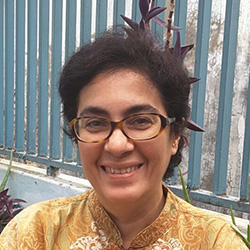Scientists and communities in Indonesia team up for peatland restoration and fire prevention efforts
The women of Dompas Village in the Indonesian province of Riau worked hard to plant 10,000 pineapple seedlings in only five days to restore a degraded peatland area as part of an agroforestry and fire prevention initiative.
The effort, led by the Center for International Forestry Research (CIFOR), encouraged community engagement in field research and allowed local people to experience direct results from their efforts.
Findings from the project are published in a new book titled “Lessons Learned from Community-Based Fire Prevention and Peatland Restoration,” which details nine lessons, including the adoption of sustainable business models and the strengthening of restoration-based monitoring systems.
Research revealed that farmers needed to understand that healthy farm ecosystems can continue to produce healthy crops although the tradition of clearing land in preparation for planting by burning has been outlawed. The process can lead to widespread fires in forests and peatlands, especially during periods of prolonged drought.

This method is no longer an option since the government began prohibiting its use after massive forest and land fires in 2015. Land preparation through burning has been believed to increase nutrient levels in soil, and has traditionally been the cheapest and fastest method for land preparation. Since 2015, the community has struggled to find suitable alternatives. Therefore, facilitating the exploration and implementation of alternative land preparation methods without the use of fire has become increasingly crucial.
“So far the communities are banned from burning but there is no example on the ground to show how to do agroforestry differently,” said Herry Purnomo, CIFOR scientist and Participatory Action Research (PAR) project leader. “This research is unique in that way, as it involves the community to prove it to themselves.”
Instead of burning biomass from peatlands before planting, farmers can use a traditional manual technique known as tebang imas.
The local farmers learned the tebang imas method of land clearing, which involves chopping residual biomass off the fields and applying herbicides under supervision. Although it was more expensive and time-consuming, they found it a much more environmentally friendly technique.
“We discussed the difference between the two methods of land clearing with the farmer communities,” said Nurul Qomar, a professor at the University of Riau’s (UNRI) Center for Disaster Studies, explaining that while some people manually clear the land using machetes, others have tried to use heavy machinery of the type often used by large companies.
However, the large machinery is unsuitable because it causes land subsidence and scrapes a layer of organic biomass off the surface of the peatlands. This results in the significant loss of organic biomass that plants need for growth.
In addition to Dompas Village in Bengkalis Regency, the research was also conducted in Siak and Pelalawan Regencies in collaboration with the Fire Care Community (MPA), village government and other community groups.
International cooperation
Between 2018 and 2019, the year-and-a-half long Participatory Action Research (PAR) was conducted jointly by CIFOR, UNRI, the Commonwealth Scientific and Industrial Research Organization (CSIRO) and Gadjah Mada University. The program was supported by Temasek Foundation and managed by the Singapore Cooperation Enterprise.
Widespread land and forest fires in Indonesia in 2015 sparked an air pollution crisis in Southeast Asia. Dry conditions and the delayed onset of seasonal rains contributed to extensive landscape fires and haze that exacerbated the air quality in the region and the health of millions of people. CIFOR researchers found that the event resulted in carbon emissions of at least 289 million tons, and associated carbon dioxide-equivalent emissions of at least 1.2 billion tons.
As a region that faces various types of disasters, communities in Asia need to be better prepared, said Temasek Foundation (TF) Senior Director Joanne Ng, adding that fostering international exchange and enhancing regional capabilities in the area of disaster-preparedness is one key focus area for Temasek Foundation.
“We hope that the research findings and community-based models from the program will benefit the communities in the Dompas area and also be a useful reference for other communities facing similar issues,” she said.
In addition to learning about new methods of land clearing, the community also improved canal blocking constructions that maintain the water table in peatlands to keep them moist or wet. To aid in restoration, they planted hardwood timber tree species such as meranti-rawa (Shorea spp.), gaharu (agarwood; Aquilaria spp).
They also engage in other economic activities such as fish cultivation, intercropping liberica coffee and rubber, developing hybrid coconut in community gardens and strengthening community institutions and farmer groups.
The keyword is participation
Th research team found that communities will benefit from developing knowledge and behavioral changes simultaneously through a series of co-learning processes with the community acting as research partners.
Danie Mendham, CSIRO project leader of the research team said: “The presidential ban on burning is the main factor that has caused the reduction in burning by communities to date, but this on its own is not sustainable. It needs to be supported by behavioral change, so that communities’ preference is to use non-burning practices.”














